Choosing Cucumbers for Probiotic Pickles
I suggest using one of three types of cucumbers to ferment your probiotic pickles. First, English cucumbers, the long cucumbers normally sold tightly wrapped in plastic, work well. The second is pickling the shorter, bumpy, lighter green cucumbers. Third is the Persian cucumber (my favorite), also known as teeny tiny or cocktail cucumbers.
Do not use slicing cucumbers for fermentation. These are very smooth, dark green cucumbers, usually fat and long. Most slicing cucumbers will turn into a soggy mess during the fermentation process. Slicing cucumbers are also normally wax-coated, which disrupts the fermentation process.
Here’s my checklist for choosing good cucumbers:
- Density: When you feel the cucumber it should be heavy, like it is hydrated and has turgor pressure. If you tap your finger against it, it should not feel hollow, like yellow squash.
- Check for surface mold: Look for indentions and soft spots in the cucumbers. You do not want to buy a squishy cucumber. Cucumbers near molding will have dark, small, circular indentions or black “pocks” on the surface.
- Small is Better: The bigger the diameter of the cucumber, the soggier your pickles will be. For English cucumbers, look for one with a smaller diameter. If you are buying pickling cucumbers, go for the smaller dainty cucumbers. If you can find cocktail cucumbers, they will work fantastically.
- Color: Pickling cucumbers should be predominantly green with streaks of yellowish-green, and English cucumbers should be a solid medium green.
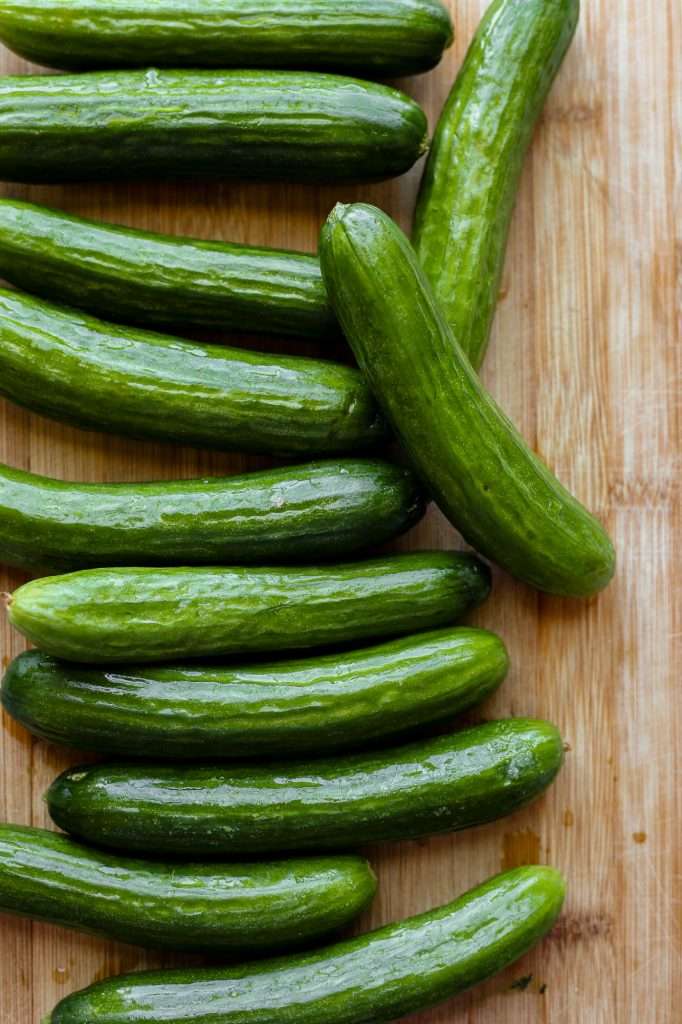
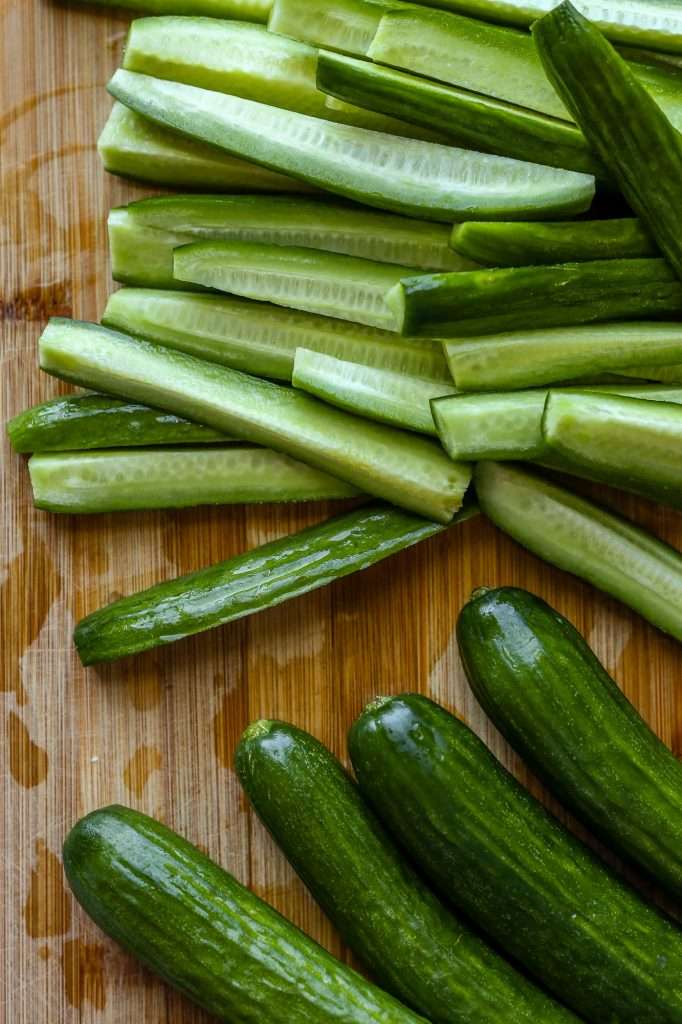
Tips for Making Fermented Mango Chili Probiotic Pickles
How you slice cucumbers impacts how the pickles hold up during fermentation. You should always remove the ends of cucumbers and not include the ends in the fermentation. The blossom end of cucumbers contains enzymes that can soften the cucumbers.
There are two slicing techniques I recommend when fermenting cucumbers into pickles.
For pickle chips, a ripple-cut pickle holds up better than a straight-sliced pickle. You can get a cheap and simple ripple cutter by clicking here.
I also suggest fermenting pickle spears or halves, which hold up even better than pickle chip slices. You can cut spears and halves with a regular knife.
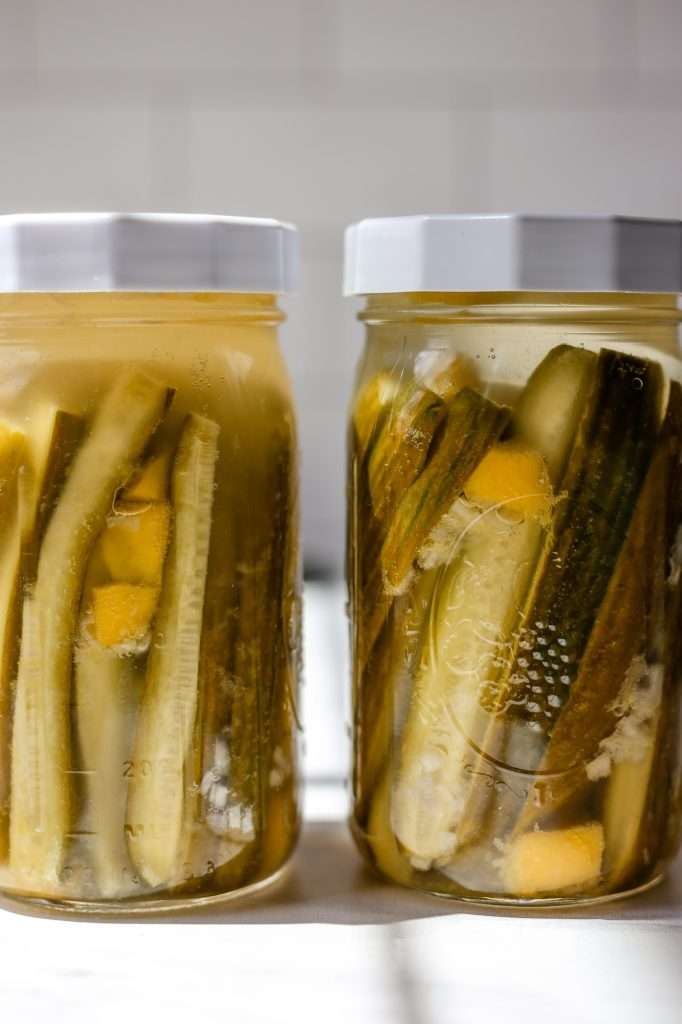
Does Pickle Juice Have Electrolytes?
Yes, fermented pickle juice does contain electrolytes. The primary electrolytes found in fermented pickle juice are sodium and potassium.
Sodium is the predominant electrolyte, crucial for maintaining fluid balance, nerve transmission, and muscle function. To make fermented pickles, you brine cucumbers in a water and salt solution, which enhances the electrolyte content as the cucumbers release their minerals into the brine.
The juice from probiotic pickles may contain smaller amounts of other minerals like calcium and magnesium, contributing to its electrolyte profile. However, electrolyte content can vary depending on the cucumbers you use and the soil they were grown in.
The easiest way to ensure fermented pickle juice has an excellent electrolyte composition is to add some natural electrolytes to the brine! I use LMNT Mango Chili Salt to give my pickles a fantastic flavor and a boost of potassium and magnesium.
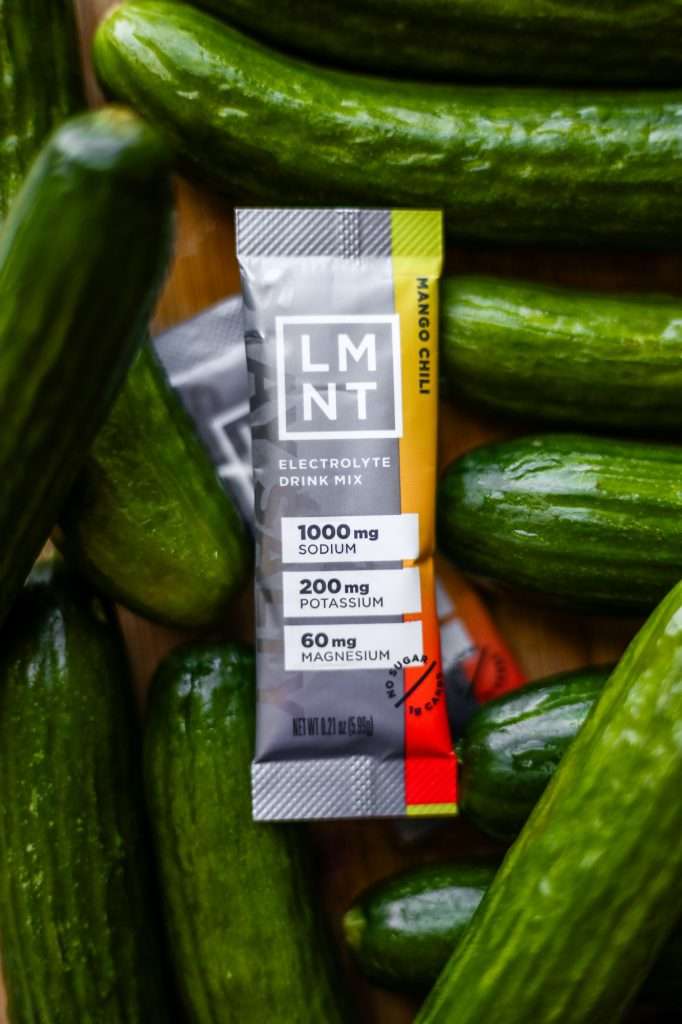
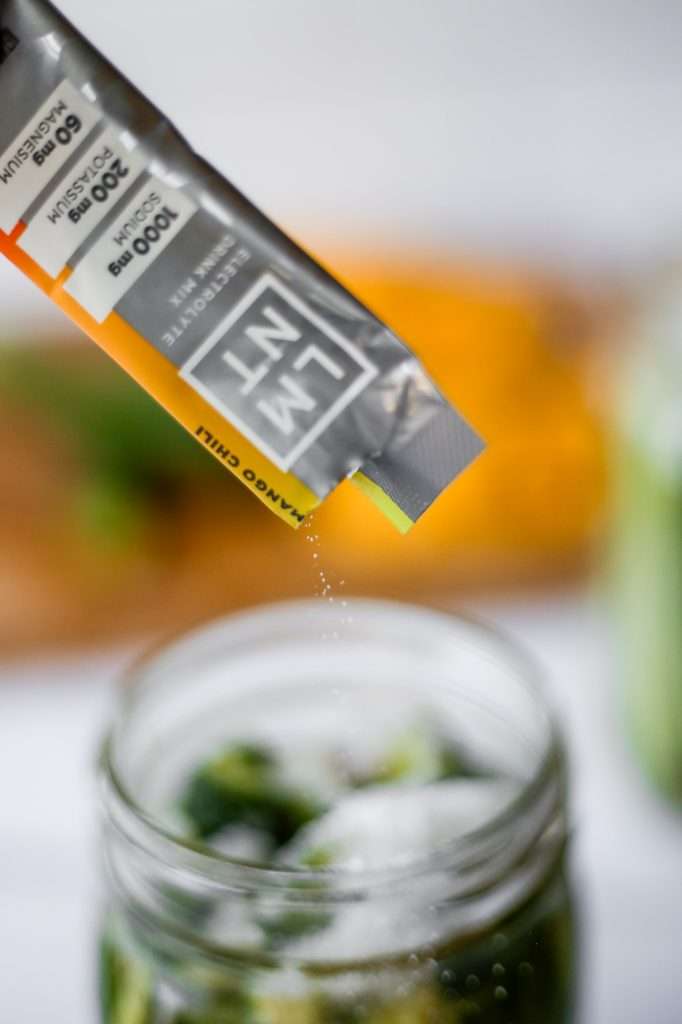
Probiotic Pickles with Mango Chili LMNT Electrolytes
What are electrolytes? Electrolytes are charged minerals that conduct electricity to power your nervous system. They also regulate hydration status by balancing fluids inside and outside all the cells in your body. LMNT electrolytes are formulated with a science-backed electrolyte ratio: 1000 mg of sodium, 200 mg of potassium, and 60 mg of magnesium.
Electrolyte balance is essential for optimal gut health. So, getting a dose of balanced electrolytes with the probiotics in fermented pickles is a win-win situation. Proper fluid balance and electrolyte intake (especially potassium and magnesium) support healthy digestion. Potassium helps the muscles in the gut contract and push digesting food forward through the intestines, while magnesium helps the muscles ahead of the food relax to allow it through.
Also, potassium and magnesium provide minerals for gut-helathy microbes to thrive.
LMNT is a no-sugar product (which I love!). They use stevia to sweeten their electrolyte drink mixes. Stevia is a natural, non-nutritive (zero-calorie) sweetener that tastes several hundred times sweeter than sugar.
Unlike zero-calorie artificial sweeteners, stevia comes from a herb, and has health benefits. For a while, some research speculated that stevia could be bad for gut health, but the opposite is true. Judging by how bubbly and active these fermented pickles were, I’d say the microorganisms involved in pickle fermentation love all the ingredients in LMNT electrolytes!
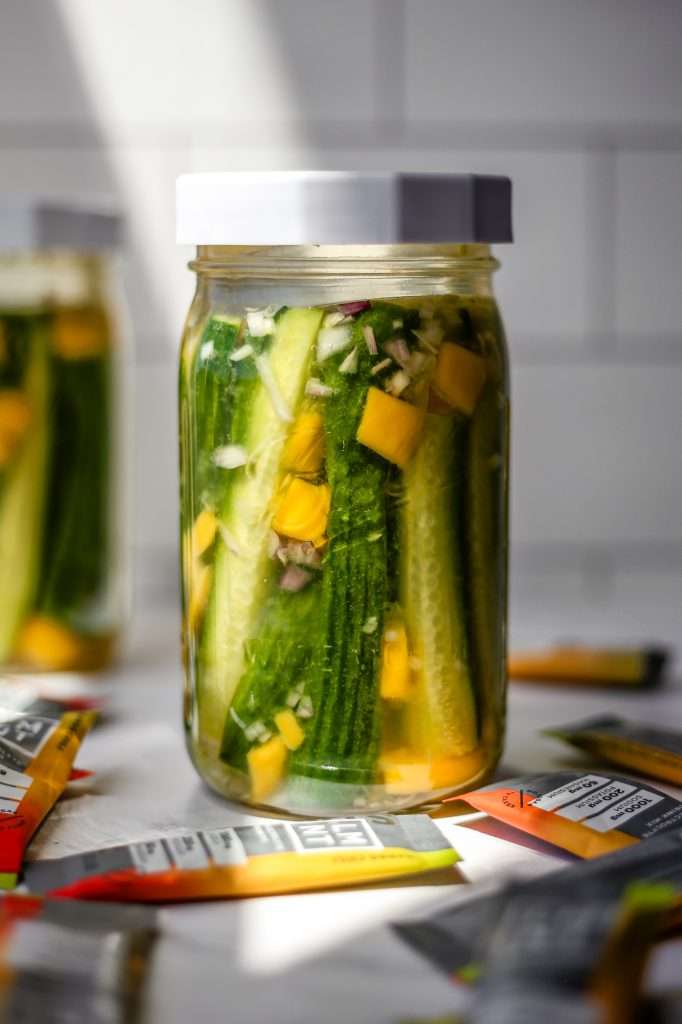
Supplies You Need to Make Probiotic Pickles
Here is the equipment you will need to make it:
- 32-ounce Wide Mouth Mason Jar
- Fermentation Weight
- Standard Metal Mason Jar Lid (this can rust in the presence of salt)
- OR Rust-Free Plastic Lid
- OR you can use a Weck Jar (without the gasket; only use the clips to secure the lid)
- Sea Salt
- Scale
- Mixing Bowl
- Ripple cutter
If you would like to read more about the best jars and lids for fermenting vegetables, click here.
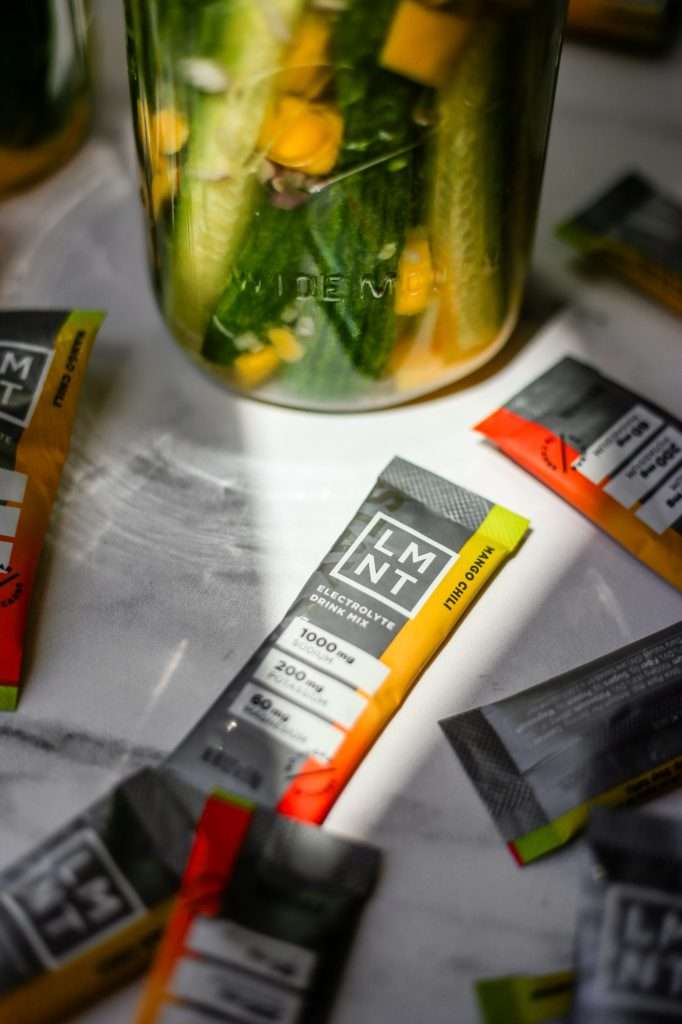
The Health Benefits of Pickles with Electrolytes
I love LMNT electrolytes and use them daily to stay hydrated in the gym. So, I am thrilled to work with our sponsor, LMNT, to share this information about electrolytes with you!
Here are some of my favorite health benefits that the Mango Chili LMNT electrolytes add to these delicious probiotic pickles:
- Improve cognitive function: Electrolytes, especially sodium, regulate fluid balance in and around the brain. They also help transmit signals between neurons—which allows us to think. Goodbye, brain fog.
- Fewer headaches: Speaking of brain health, chugging plain water can worsen headaches for some people by decreasing blood sodium levels. Healthy fluid balance in the brain = water + electrolytes.
- Fewer muscle cramps: Electrolytes transmit electrochemical signals to your muscles, instructing them when to contract and relax. Improper hydration—a lack of electrolytes—is one of the leading causes of muscle cramps.
- Digestion Regulation: Proper fluid balance and electrolyte intake (especially potassium and magnesium) support healthy digestion.
- Hydrated Skin: Hydrated skin is happy skin. Since proper hydration is about fluid balance and not just water intake, hydrating with electrolytes can help keep your skin beautiful: fewer cracked lips and dry patches.
- More Energy: Potassium and magnesium support the processes that convert stored energy (calories) into usable energy (ATP). LMNT electrolytes also impact energy by regulating hormones, maintaining fluid balance and blood pressure, regulating heartbeat, promoting restful sleep, and much more. And no afternoon slump means no need for that extra cup of coffee.
- Higher Quality Sleep: Quality sleep is critical to looking, feeling, and performing your best. Magnesium increases GABA, a neurotransmitter known for producing calming effects. Consuming adequate sodium can help you sleep through the night because low sodium levels increase cortisol and adrenaline.
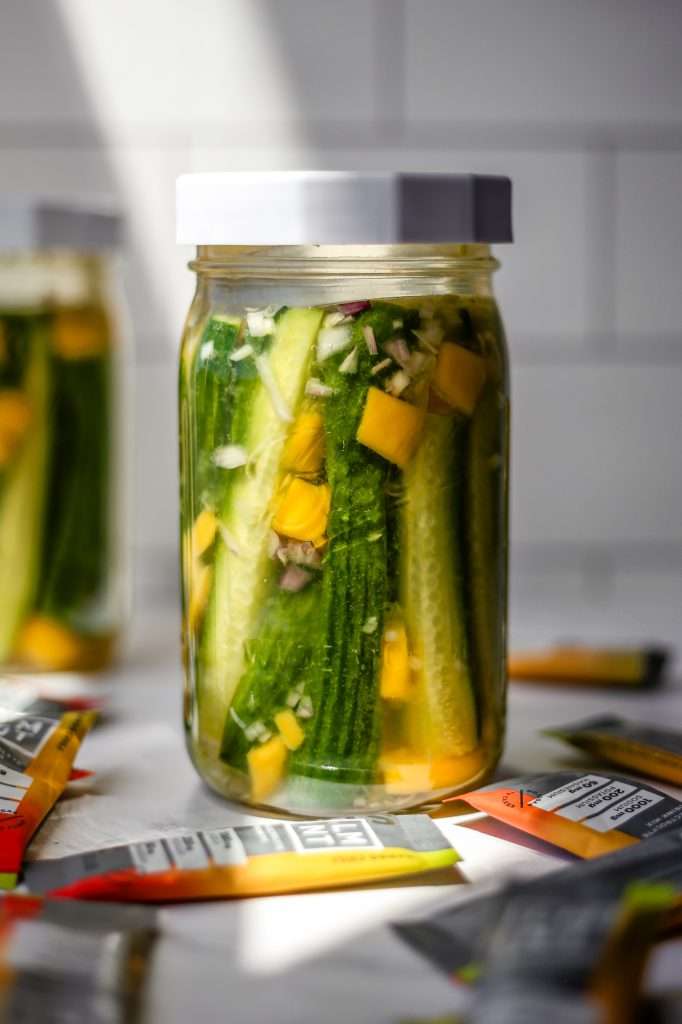
Try LMNT Electrolytes to Flavor Your Fermented Pickles!
Give your pickles a delicious fermented mango chili flavor and a healthy boost! Members of my Cultured Guru Community get a free LMNT Sample Pack with any LMNT drink mix ordered through THIS LINK (CLICK HERE).
- The LMNT Sample Pack includes 8 of our favorite LMNT drink mix flavors. This is the perfect offer for you if you want to explore and find your favorite LMNT flavor or if you want a sample pack to share LMNT with a friend.
- This offer is available exclusively through my partnership with LMNT – you won’t find this offer elsewhere!
- This offer is available for new and returning LMNT customers who click THIS LINK (CLICK HERE); you can get a free Sample Pack with every LMNT order purchased through my link.
- LMNT has a no-questions-asked refund policy. If you don’t like LMNT for any reason, email [email protected]
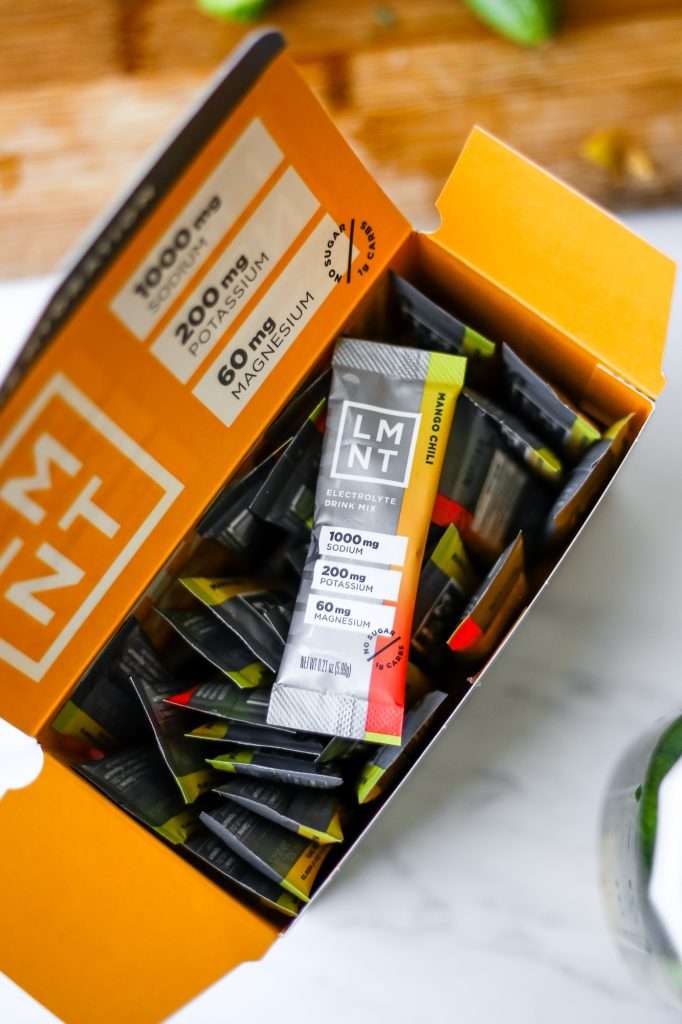
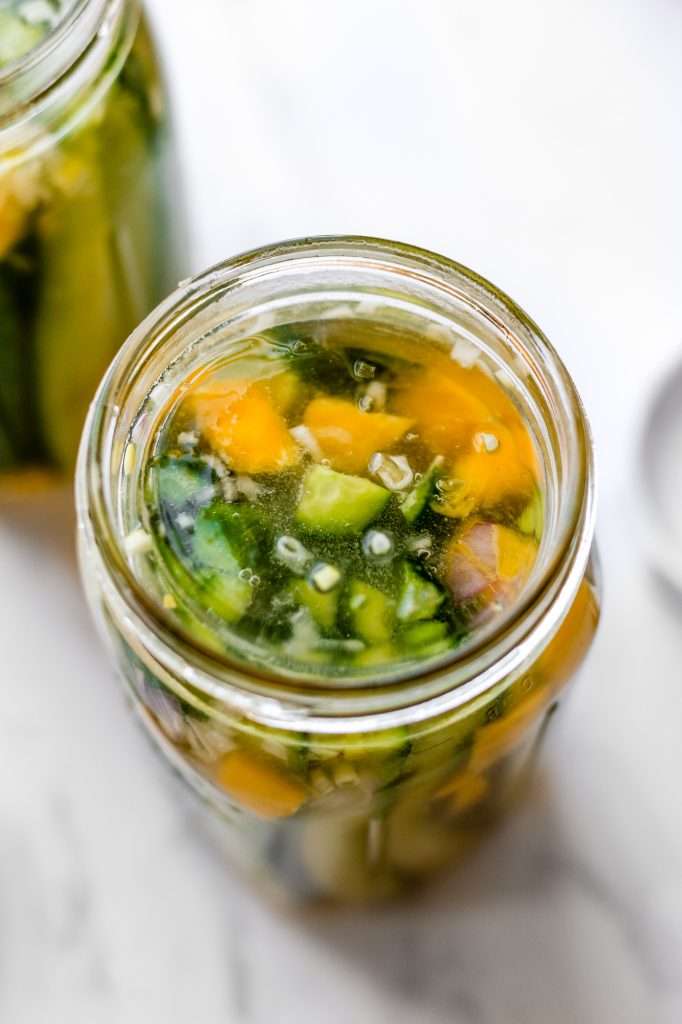
Mango Chili Probiotic Pickles Fermentation Timeline
We tracked our fermented pickles throughout the fermentation process. If you follow our recipe and directions, your timeline for fermented cucumbers should approximately match ours. This timeline is for fermenting cucumbers at 72-78 degrees F. The process will be slower in colder conditions and faster in warmer conditions.
24 – 72 hours: All contents in the jar should be submerged beneath the brine. At this time, there are still Gram negative bacteria and possible pathogens present. This is normal, and these bacteria will be eliminated by bacterial succession.
72 hours – 7 days: After 72 hours, you should start to see lots of bubbles. You need to burp the jar if you are using a standard mason jar and lid. Cucumbers in this stage should change color from vibrant green to pale olive. Also, you will notice the brine become very cloudy. Leuconostoc bacteria begin to thrive and produce a lot of carbon dioxide and acetic acid. Gram negative organisms die off during this time.
7 – 12 days: Next, bubbles in the brine will decrease as the ferment leaves stage two and enters stage three. The mixture will become cloudy and start to develop a pleasantly sour smell. Lactobacillus species are most abundant during this time period.
12 – 14 days: Lactobacillus make up the majority or all of the microbial population. They produce copious amounts of lactic acid, and make the fermented cucumbers smell even more pleasantly sour. This is the time in which the vegetable mixture becomes preserved. So, at this time, you can smell and taste test.
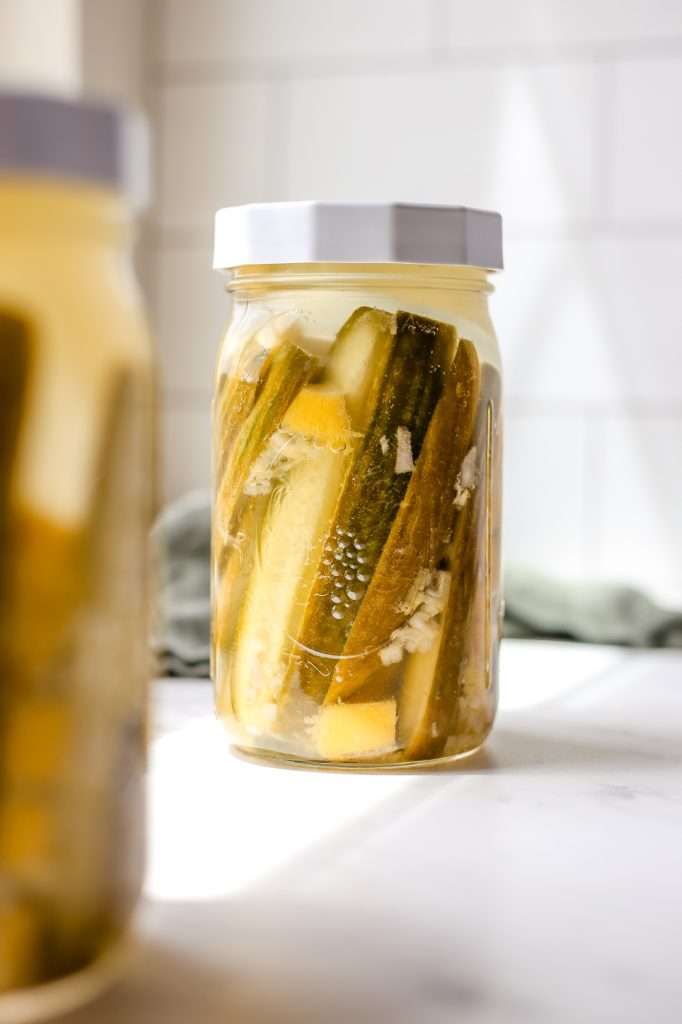
Using the Electrolyte Rich Pickle Brine
After you eat your delicious fermented mango chili probiotic pickles, you’ll have a lot of electrolyte-rich pickle brine left over. Keep the brine! You can take a shot of it to get a quick dose of probiotics and electrolytes, or you can try some fun recipes that call for fermented brine!
- Fermented Quick Pickled Red Onions
- How to Make Fermented Cherry Tomatoes
- Easy Fermented Quick Pickled Carrots
More Pickle Recipes to Try
- Fermented Cucumbers: Fermenting Sliced Cucumbers Two Ways
- Full Sour Fermented Old Bay Pickles with Crushed Garlic
- Fermented Green Tomato Pickles
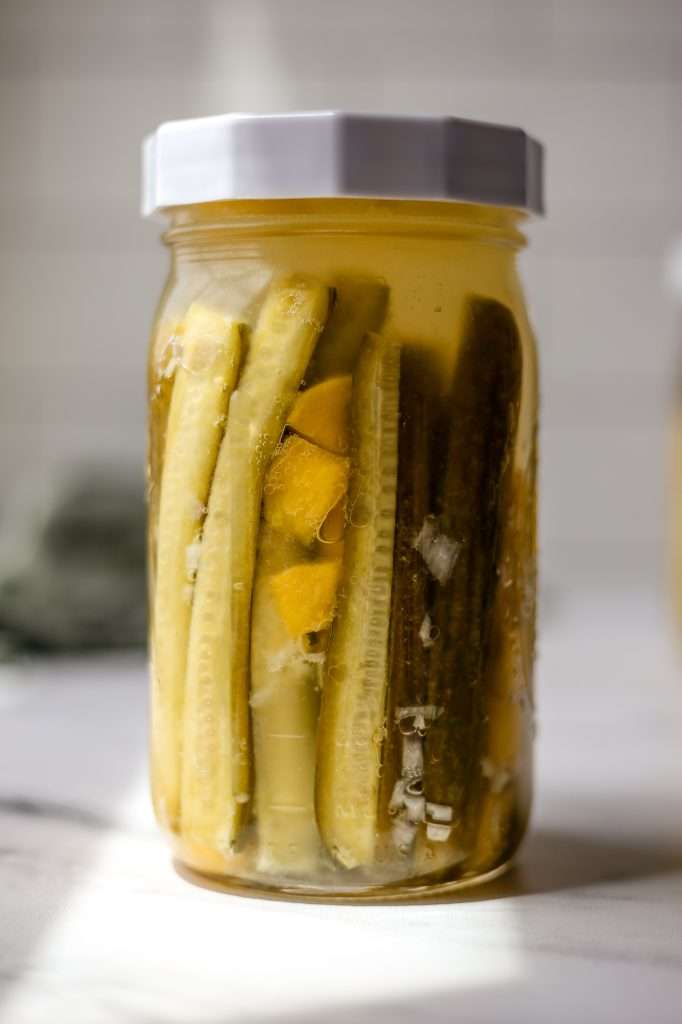

Fermented Mango Chili Probiotic Pickles With Electrolytes
Boost your gut health and get a dose of electrolytes with my easy Fermented Mango Chili Probiotic Pickles recipe! With Mango Chili LMNT Electrolytes, these pickles are perfectly flavored and provide sodium, potassium, and magnesium for effective hydration.
- Prep: 10 minutes
- Total Time: 336 hours 10 minutes
Ingredients
- 360 grams cucumber
- 100 grams fresh mango
- 20 grams minced shallot
- a pinch of red pepper flakes (optional)
- 27 grams salt
- 1 packet LMNT Chili Mango Electrolytes
- 320 grams water
Instructions
- This recipe at 1x works best with a 32-ounce wide-mouth jar. Please see the equipment recommendations above. Please use the right type of cucumber. The recommendations can be found in the first paragraph of the blog post. Please also read the slicing recommendations.
- Wash all of your fermentation equipment (jar, weight and lid)
- Wash your cucumbers in cool water.
- Slice your cucumbers either as ripple-cut chips or as spears/halves. Peel and chop the mango.
- Place your kitchen scale on the counter. Turn it on and set it to weigh in grams.
- Place a mixing bowl on your kitchen scale and tare/zero the scale.
- Weigh out the designated amount of cucumbers, shallot and mango.
- Add the cucumbers, mango, shallots, and the designated amount of water to the jar.
- Place a small bowl on your scale and tare/zero the scale.
- Weigh out the salt. Then add the salt to the jar of cucumber, mango and water. Add the packet of LMNT mango chili electrolytes. Add a pinch of red pepper flakes if you like it spicy.
- Place the standard mason jar lid on the jar and secure it. Shake the jar vigorously for 2 minutes to dissolve all the salt.
- Remove the lid. Place your clean fermentation weight in the jar, making sure to submerge the cucumber pieces and weight fully in the liquid.
- Secure the lid to the jar. You will need to burp the jar daily when it is bubbling. You do not need to tighten it all the way. Just secure the lid but leave it ever so slightly loose, so the gas doesn’t build up too much.
- Let the pickles ferment for 14 days at room temperature. Set the jar in a glass dish to catch any spills.
- After 2 weeks, remove the fermentation weight and smell and taste test. Your fermented pickles should smell pleasantly sour and be lightly sweet from the LMNT mango chili electrolytes.
- Store in the fridge.















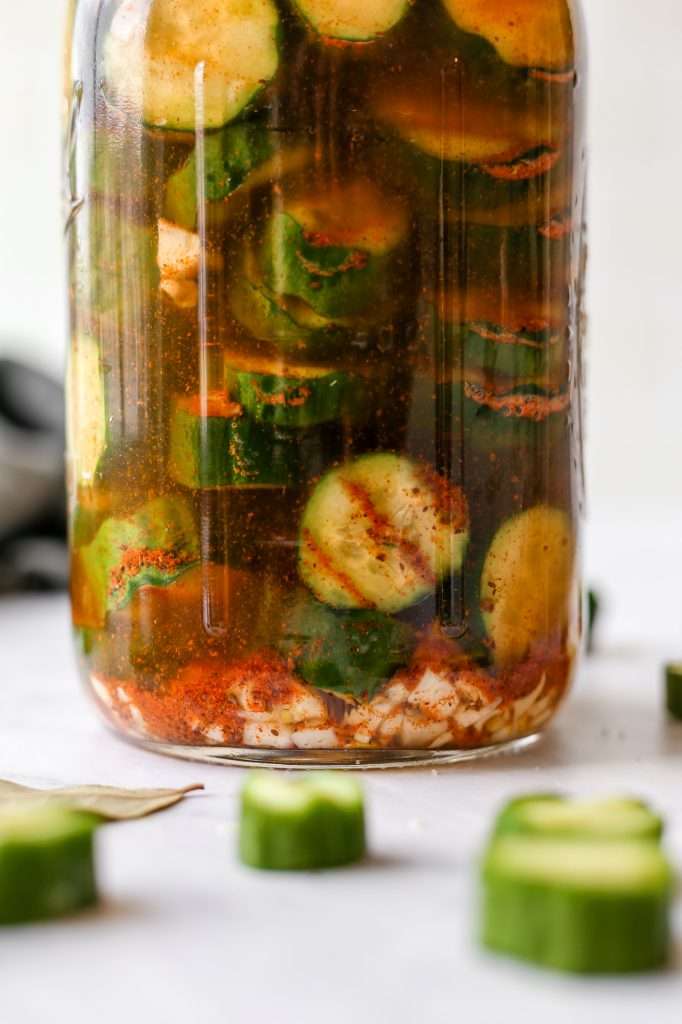

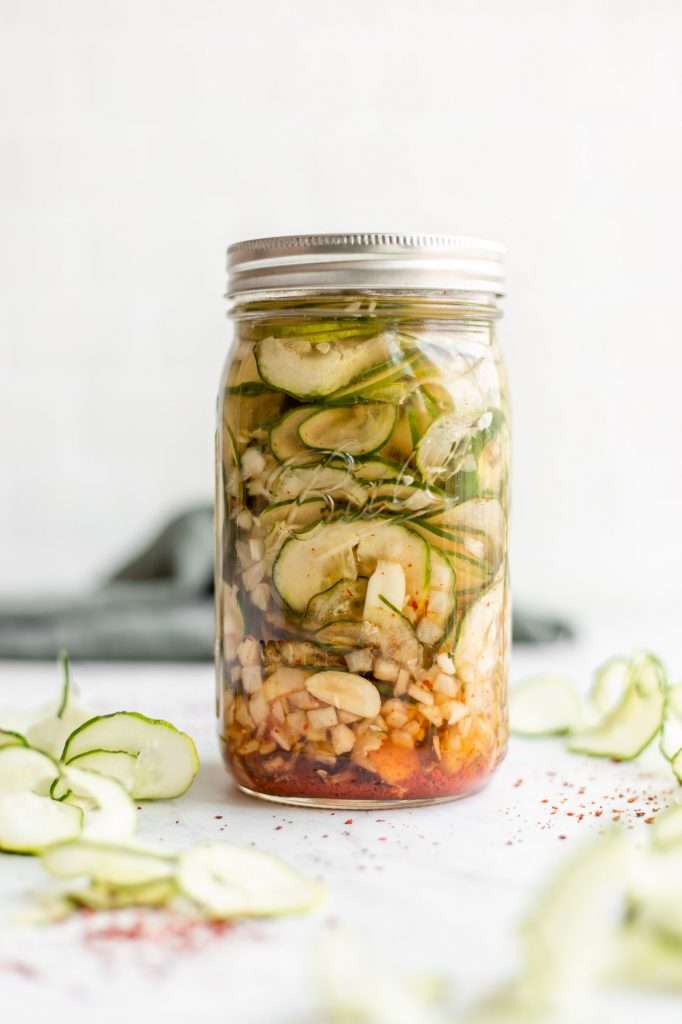

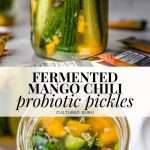
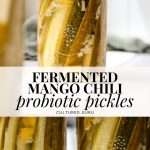
Thank you so much for sharing your recipes. I was wondering if the LMNT mango chili electrolytes are a necessary ingredient? Thank you.
For the flavor, yes! You can use this recipe instead for regular fermented pickles Fermented Cucumbers: Fermenting Sliced Cucumbers Two Ways
Could stevia be used by itself with some chili seasoning? The LMT product is pricey.
sure! Not sure how much to sub for, but feel free to experiment.
After 2 weeks, my pickles smell great, the liquid tastes good, but there is a white powdery layer on the top. The fermentation weight “fell” into the jar … I tried to skim off the white substance but couldn’t get all of it and it dispersed into the liquid. Thoughts????
a white layer on the surface of the liquid, or on the fermentation weight under the brine? It sounds like it might be kahm yeast, which isn’t an issue, but I’d need a picture to know for sure.
I guess I can’t figure out how to share a photo … I tried to paste in here, but no luck. If you think it is yeast, I bet you are correct. I felt it was okay to taste, and it was delicious – spicy, crunchy, yummy.